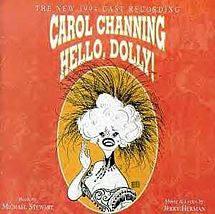
From Broadway To 52nd Street
Hello Dolly opened at the St. James Theatre on January 16, 1964 with music composed by Jerry Herman. The show starred Carol Channing & David Burns, Eileen Brennan, Sondra Lee and Charles Nelson Reilly, running for a record 2,844 performances landing it amongst the grand collection of blockbuster hits. It was revived in 1967 with Pearl Bailey & Cab Calloway in the lead roles and in 1969, Barbra Streisand & Walter Matthau took the characters to the silver screen. The title song Hello Dolly and It Only Takes A Moment went on to become a part of the jazz catalogue.
The Story: At the turn of the 20th century in New York City, a brassy and intrepid matchmaker Dolly Galagher Levi is in town to find wealthy Horace Vandergelder a wife. However, unbeknownst to Horace, Ms. Levi has her sights set on him herself. While helping two rich pretenders to find love, Dolly finds romance and a husband for herself in this spoof on love and marriage.
Broadway History: Broadway, previously the home to jazz influenced choreographers like Cole, Fosse, and Robbins, saw a part of its nature change to reflect the mood of the country. While there were still blockbuster musicals of the old type – like My Fair Lady, Hello Dolly, Mame – a new generation of musicals reflected the changes in American society, and dance. Hair was a depiction of the rebellious nature of the hippie movement. And Fosse, that champion of syncopated, tap and minstrel based movement, absorbed the new 60s feel of dance with his hit musical Sweet Charity. In this show, Fosse based much of his movement on the social dances of the 1960s, while injecting his own unique brand of style and angular movement and jutting body parts. The movements of jazz dance had evolved to absorb the blossoming social scene. Broadway was no longer the spawning ground for theatrical jazz dance. It had become a pastiche of old standard styles and movements, and an incubator for a new form of jazz dance.
Sponsored By
www.whatissuitetabu.com
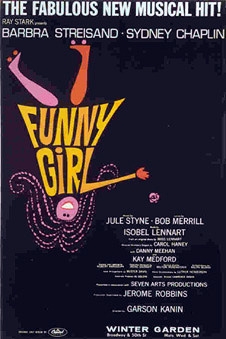
From Broadway To 52nd Street
Funny Girl opened at the Winter Garden Theatre on March 26, 1964 and entered into the fraternity of blockbuster musicals with 1,348 performances. Jule Styne & Robert Merrill composed the music and from the score came the classic tune People, that became a hit long before it premiered on Broadway performed by Barbra Streisand. Joining her in the cast of players were Sydney Chaplin, Jean Stapleton and Lainie Kazan.
The Story: The early years of Ziegfield Follies star Fanny Brice in which Streisand recreates her Broadway triumph. She reminisces about her life as she wanders back to the days of Keeney’s Music hall, her eventual success and the two men in her life. There’s Flo Ziegfeld, who makes her a star and Nicky Arnstein, a gambler, who she marries. Her career flourishes as Nicky’s gambling and prison sentence destroy her marriage. She sings, roller-skates, cracks jokes, loves & marries a gambler, and tugs at your heart in a tour-de-force performance)
Jazz History: The Sixties was the most tumultuous decade in the history of America and the changes were reflected in jazz. Many musicians were falling under the modal-jazz spell of Miles Davis’ Kind of Blue, and the free-jazz influence of saxophonist Ornette Coleman; John Coltrane performs in concert as a member of Miles Davis’ group for the last time, riots break out at the Newport Jazz Festival and Max Roach begins to record his Freedom Now! Suite. The country saw John F. Kennedy elected as the youngest President in U.S. history, we lived the Cuban missile crisis, student sit-ins and segregation protests at restaurants, and the San Francisco Chronicle reports that Dave Brubeck lost $40,000 in bookings from a month-long tour of U.S. southern states because he refused to drop African-American bassist Eugene Wright from his group.
Sponsored By
www.whatissuitetabu.com
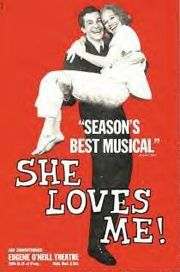
From Broadway To 52nd Street
She Loves Me opened the Eugene O’Neill Theatre on April 23, 1963 and the show ran for 301 performances. Sheldon Harnick penned the lyrics and Jerry Bock composed the music to the tune She Loves Me which has entered into the pantheon of jazz standards. The musical starred Barbara Cook, Daniel Massey, Barbara Baxley and Jack Cassidy.
The Story: Set in Hungary in the late 1930s, the story follows two coworkers George and Amalia who unwittingly meet through a Lonely Hearts column. As the two anonymously write love letters to each other, things don’t go so well at work. Not knowing that they are each other’s pen pal, they constantly fight. Further Georg’s boss, Mr. Maraczek, who thinks George is having an affair with his wife, constantly criticizes George at work. Eventually, the boss realizes that another clerk is having the affair. In the end Georg and Amalia discover that they are each other’s pen pal and they fall in love.
Broadway History: The alternative theatre movement aimed to break these commercial and psychological restraints by bonding spectator and audience and by lessening the theatrical illusion of an imagined space and time. Conventional theatre taught the spectator to lose himself in the fictional onstage time, space, and characters; conversely, alternative theatre relied on the spectator’s complete consciousness of the present. This present is the real time and space shared by the audience and the performers; only when the audience consciously perceives the present can they perceive the theatrical experience as relevant to their lives, and not as escapist fiction. The primary importance of the spectator’s consciousness of the present is that he is an active force in creating the theatrical event rather than a passive observer of a ready-made production.
Sponsored By
www.whatissuitetabu.com
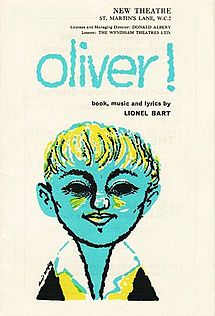
From Broadway To 52nd Street
Oliver! opened at the Imperial Theatre on January 6, 1963 and ran 774 performances. Lionel Bart wrote the book and the lyrics and composed the music. One of his songs, Where Is Love became a jazz favorite.
The Story: Musical adaptation of Dickens story in which a young Oliver, an orphan in a workhouse, asks for more of the meager gruel from a surprised matron. Punished for beating up another boy who made fun of his dead mother and locked in a coffin but he escapes. Living on the streets of London he is befriended by the Artful Dodger who introduces him to Fagin, a criminal teaching young boys to become pickpockets. The thieving children are manipulated by their leader and mentor Fagin, and the young Oliver, who through circumstances is forced into a life of crime. Greed of the workhouse caretakers leads to Oliver’s ultimate rescue by a kindly old gentleman who realizes Oliver is his great nephew. The musical, as is the book, was a powerful statement on the 19th century poverty, crime and government neglect crying out for social reform.
Jazz History: By the 1960s, most of the legendary clubs were razed or fell into disrepair. The last club there closed its doors in 1968. Today, the street is full of banks, shops, and department stores and shows little trace of its jazz history. The block from 5th to 6th Avenues is formally co-named “Swing Street” and one block west is called “W. C. Handys Place”.
The 21 Club is the sole surviving club on 52nd Street that also existed during the 1940s. The venue for the original Birdland at 1674 Broadway (between 52nd & 53rd), which came into existence in 1949, is now a “gentlemen’s club”. The current Birdland is on 44th Street, between 8th and 9th Avenues.
Sponsored By
www.whatissuitetabu.com
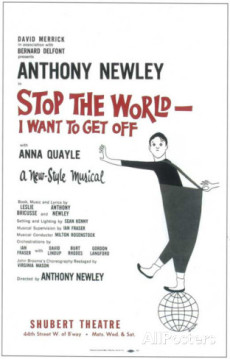
From Broadway To 52nd Street
Stop The World I Want To Get Off opened at the Shubert Theatre on October 2, 1962. Running for 555 performances The music and lyrics were composed by Leslie Bricusse and Anthony Newley. The musical starred Anthony Newley as Littlechap and Anna Quayle portrays Evie. Fortunately for the jazz world one of their tunes would enter the pantheon of jazz classics – What Kind Of Fool Am I.
The Story: Set against the backdrop of a circus, it focuses on Littlechap, whose first major step towards improving his lot is to marry Evie, his boss’ daughter. Saddled with the responsibilities of a family, he allows his growing dissatisfaction with his existence to lead him into the arms of various women – Russian Anya, German Ilse, and American Ginnie – as he searches for something better than he has, only to realize in the twilight of his life what he always had – the love of his wife – was more than enough to sustain him.
Broadway History: In 1950, the tradition of the gypsy robe was born on Broadway, when a chorus member in Gentlemen Prefer Blondes sent the worn-out robe of a fellow chorus member to a friend in a different production. Since then, the robe has been passed to the chorus member with the most credits on the opening night of Broadway plays, with each former “gypsy” adding a prop from his or her performance.
Sponsored By
www.whatissuitetabu.com


